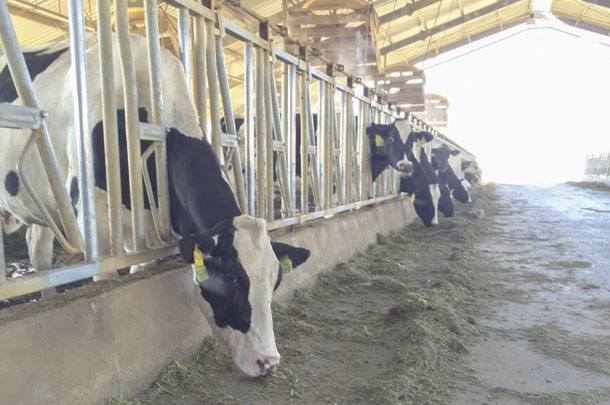When reproduction rates drop, it’s easy to point the finger at your breeder. Naturally, we want to assign blame; finding the source of the issue means we can work toward a solution that much faster.
While it may be that semen has been mishandled or their insemination practices aren’t as they should be, it’s rarely as simple as that.
The reality is that reproduction issues are often a combination of many things, and the finger can’t be pointed in any one direction. Poor repro rates are more likely to be an indicator that something is wrong with your facility as a whole than just your breeding practices.
If a cow’s primary needs aren’t being met, a secondary function like reproduction will take a back seat in favor of her more important needs. From herd management and facility design to cow comfort and cow cooling solutions, every aspect of your facility will affect your cows and play a part in their reproductive health.
If your repro guy isn’t hitting the mark, take a look around your facility and listen to what the cows are telling you.
Q. How many cows are lying down in beds, and how many are perching or standing?
You’ve heard it before, but it warrants saying again. Happy cows that spend a good portion of their days lying down in comfortable stalls not only produce more milk, they also are more likely to have better reproductive health than their standing and perching counterparts.
A lactating cow’s primary role is to feed her fictitious calf – if her body isn’t comfortably doing that, then she isn’t likely to have the energy to spare to care for the next pregnancy.
Standing and perching can mean a few things …
A. There is an issue with your freestalls: This, again, isn’t one of those simple, one-answer-solves-all questions. There are several factors that can lead to cows not using the freestalls. I suggest you start by asking a few key questions:
1. Are stall dimensions the right size? If your freestalls aren’t the right size for the age group you’re working with, then cows will either lie incorrectly or choose not to lie down at all. Lunge obstructions will also keep cows from entering and lying down in stalls.
2. What type of bedding is being used? If you’re using compost, sand or mattresses, it’s important the material is managed correctly. If there are large mounds or lumps of sand or compost in the bed, it can be difficult for cows to lie down. If there are deep hollows that leave the back curb exposed, you run the risk of unnecessary injury and provide less room for the cows. If the mattress is not soft enough, you will end up with hock lesions, and the bed won’t be comfortable for long resting periods.
B.Your cows are suffering from heat stress: A high-producing dairy cow can produce the same amount of heat each hour as a 1,500-watt hair dryer. Even a mild increase in temperature can cause cows to stand to cool themselves. A good rule of thumb is if you are comfortable walking around in a sweater or jacket, your cows are too hot.
Q. Are cows’ body condition scores reflective of the normal scores for their stage of lactation?
Feed intake is a direct contributor to reproduction issues. If a cow isn’t getting enough to eat to meet her own needs and support milk production, energy will not be available to support a pregnancy.
Body condition score issues can mean:
There isn’t enough availability at the feedbunk: Ensuring there is enough feed at the feedbunk for each cow can be a challenge. Herd mentality will send the group up to eat all at the same time, and timid cows will lag behind or be pushed out of the way by more dominant animals.

1. Is your management style in line with your stocking rates? How you manage a four-row barn with 100 percent freestall occupancy will be different than how you manage a six-row barn with that same 100 percent freestall occupancy.
The four-row barn will have 80 to 90 percent stocking rate at the feed face, while the six-row barn will be at least 130 percent or greater. The higher your feed-face stocking rate, the more often you should be pushing feed up to make sure the second round of cows have enough to eat.
2. Where is your feed sitting in the feedbunk? If feed is sitting back from the feedbunk, you should probably be pushing up more frequently. It means cows have eaten their reach and can’t access more. If repro rates are down, and this is a common sight in your facility, the two may be connected. It can’t hurt to adjust your schedule and see if repro rates increase.
Q. How healthy are your cows?
Overall animal health plays a big part in reproductive heath. Aside from the obvious post-calving animal health and repro issues, lameness and mastitis will also negatively impact repro rates. If these groups of cows ovulate, they exhibit fewer signs of estrous, which makes heat detection more challenging and leads to lower conception rates.
Q. Is your herd showing signs of heat stress?
Heat stress is one of those things that affects everything from feed intake and milk yield to cow behavior and reproductive efficiency. While adult cows are cold-tolerant, they are affected by slight increases in ambient temperature. We’re only starting to talk about how cow cooling and ventilation affect reproduction and unborn calves.
Heat-stressed dairy cows are less active and less likely to exhibit estrous activity. Their fluctuating body temperature makes them more likely to miscarry, and the risk of early pregnancy loss increases. The difficulty is that reproductive losses can start before you see obvious signs of heat stress, and reduced fertility can extend well past the heat stress period.
1. Is your herd standing and bunching at fresh air intakes or in shade? This is a sign cows are suffering from heat stress and looking for clean, fresh air. Increasing airspeed at the cow level with the aid of recirculation fans over freestalls or feed fronts can help.
2. Has feed intake or milk yield dropped? We’ve all seen the effects of hot summer months on feed intake and milk production. As some of the more visible and well-documented signs of heat stress, they are hard to miss. Adding cooling in the form of feedlane soaking, high-pressure fogging or both, based on your environment, will help – more so if you’re adding the cooling in combination with fans.
It’s important to remember that what impacts milk production will also impact reproduction. Approaching reproductive health with a big picture mindset encompassing all aspects of facility management, animal health and cow comfort will give you better results in the long run. Set your herd, and the next generation, up to reach their genetic potential. ![]()
PHOTO 1: Cows housed in a comfortable environment with correctly sized, well-maintained stalls and adequate cooling are better able to show heats and become pregnant.
PHOTO 2: f feed is sitting back from the feedbunk, more frequent pushups may be necessary. If repro rates are down, and this is a common sight in your facility, the two may be connected. Photos courtesy of Artex.
References omitted but are available upon request. Click here to email an editor.

-
Sue Hagenson
- Senior Dairy Specialist
- Artex Barn Solutions
- Email Sue Hagenson






